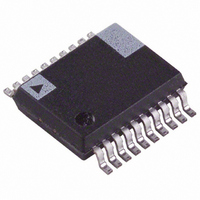ADE7763ARS Analog Devices Inc, ADE7763ARS Datasheet - Page 35

ADE7763ARS
Manufacturer Part Number
ADE7763ARS
Description
IC ENERGY METER 1PHASE 20SSOP
Manufacturer
Analog Devices Inc
Specifications of ADE7763ARS
Input Impedance
390 KOhm
Measurement Error
0.1%
Voltage - I/o High
2.4V
Voltage - I/o Low
0.8V
Current - Supply
3mA
Voltage - Supply
4.75 V ~ 5.25 V
Operating Temperature
-40°C ~ 85°C
Mounting Type
Surface Mount
Package / Case
20-SSOP (0.200", 5.30mm Width)
Meter Type
Single Phase
For Use With
EVAL-ADE7763ZEB - BOARD EVALUATION FOR ADE7763
Lead Free Status / RoHS Status
Contains lead / RoHS non-compliant
Available stocks
Company
Part Number
Manufacturer
Quantity
Price
Part Number:
ADE7763ARS
Manufacturer:
ADI/亚德诺
Quantity:
20 000
Part Number:
ADE7763ARSZ
Manufacturer:
ADI/亚德诺
Quantity:
20 000
Part Number:
ADE7763ARSZRL
Manufacturer:
ADI/亚德诺
Quantity:
20 000
Watt Gain
The first step of calibrating the gain is to define the line voltage,
the base current, and the maximum current for the meter. A
meter constant, such as 3200 imp/kWh or 3.2 imp/Wh, needs to
be determined for CF. Note that the line voltage and the
maximum current scale to half of their respective analog input
ranges in this example.
The expected CF in Hz is
where:
cos
The ratio of active energy LSBs per CF pulse is adjusted using
the CFNUM, CFDEN, and WDIV registers.
The relationship between watt-hours accumulated and the
quantity read from AENERGY can be determined from the
amount of active energy accumulated over time with a
given load:
where Accumulation Time can be determined from the value in
the line period and the number of half line cycles fixed in the
LINECYC register.
The line period can be determined from the period register:
The AENERGY Wh/LSB ratio can also be expressed in terms of
the meter constant:
In a meter design, WDIV, CFNUM, and CFDEN should be kept
constant across all meters to ensure that the Wh/LSB constant is
maintained. Leaving WDIV at its default value of 0 ensures
maximum resolution. The WDIV register is not included in the
CF signal chain, so it does not affect the frequency pulse output.
The WGAIN register is used to finely calibrate each meter. Cali-
brating the WGAIN register changes both CF and AENERGY for
a given load condition.
ϕ
is the angle between I and V.
(ϕ
CF
CF
Accumulation time(s) =
Line Period(s) = PERIOD ×
Wh
Wh
MeterConst
)
expected
is the power factor.
expected
LSB
LSB
(Hz) =
=
=
=
Accumulati
Load
MeterConst
ant
(
(
CFNUM
CFDEN
3600
LAENERGY
(
(W)
LAENERGY
imp/Wh
s/h
×
onTime
+
+
Accumulati
ant
LINECYC
) 1
) 1
)
× Load
(imp/Wh)
×
CLKIN
(s)
WDIV
×
×
8
3600
WDIV
(
W
on
IB
×
)
s/h
Time
2
×
×
Line
cos(
(
(
CFNUM
CFDEN
(
Period
s
ϕ
)
)
+
+
(s
) 1
) 1
)
(30)
(31)
(32)
(33)
(34)
(35)
Rev. B | Page 35 of 56
When calibrating with a reference meter, WGAIN is adjusted
until CF matches the reference meter pulse output. If an
accurate source is used to calibrate, WGAIN will be modified
until the active energy accumulation rate yields the expected CF
pulse rate.
The steps of designing and calibrating the active energy portion
of a meter with either a reference meter or an accurate source
are outlined in the following examples. The specifications for
this example are
Meter Constant:
Base Current:
Maximum Current:
Line Voltage:
Line Frequency:
The first step in calibration with either a reference meter or an
accurate source is to calculate the CF denominator, CFDEN.
This is done by comparing the expected CF pulse output to the
nominal CF output with the default CFDEN = 0x3F and
CFNUM = 0x3F when the base current is applied.
The expected CF output for this meter with the base current
applied is 1.9556 Hz using Equation 30.
Alternatively, CF
pulse output.
The maximum CF frequency measured without any frequency
division and with ac inputs at full scale is 23 kHz. For this
example, the nominal CF with the test current, I
958 Hz. In this example the line voltage and maximum current
scale half of their respective analog input ranges. The line
voltage and maximum current should not be fixed at the
maximum analog inputs to account for occurrences such as
spikes on the line.
The nominal CF on a sample set of meters should be measured
using the default CFDEN, CFNUM, and WDIV to ensure that
the best CFDEN is chosen for the design.
AENERGY
CF
CF
CF
CF
CF
. 3
200
expected
IB(expected)
expected
nominal
IB(nominal)
imp/Wh
(Hz) = CF
(Hz) =
(Hz) = CF
(Hz) =
(Hz) =
expected
3600
expected
×
23
= AENERGY
s/h
10
can be measured from a reference meter
23
ref
nominal
kHz
A
kHz
×
×
×
MeterConstant(imp/Wh) = 3.2
I
I
V
f
220
l
b
MAX
×
1
nominal
= 50 Hz
= 10 A
2
(
(
1
CFNUM
CFDEN
V
×
2
= 60 A
nominal
×
1
×
= 220 V
2
1
cos(
×
2
×
×
I
MAX
+
10
⎛ +
⎜
⎝
+
ϕ
I
1
) 1
)
) 1
60
=
×
WGAIN
. 1
=
9556
⎛ +
⎜
⎝
2
b
958
1
, applied is
12
ADE7763
WGAIN
Hz
Hz
⎞
⎟
⎠
2
12
(36)
(37)
(38)
(39)
⎞
⎟
⎠













